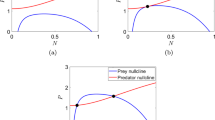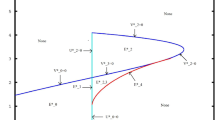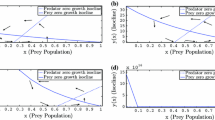Abstract
In this paper, a mathematical model of a prey-predator system is proposed to resolve the paradox of enrichment in ecosystems. The model is based on the natural strategy that a predator takes, i.e, it produces resting eggs in harsh environment. Our result gives a criterion for a functional response, which ensures that entering dormancy stabilizes the population dynamics. It is also shown that the hatching of resting eggs can stabilize the population dynamics when the switching between non-resting and resting eggs is sharp. Furthermore, the bifurcation structure of our model suggests the simultaneous existence of a stable equilibrium and a large amplitude cycle in natural enriched environments.
Similar content being viewed by others
References
Abrams P.A., Walters C.J.: Invulnerable prey and the paradox of enrichment. Ecology 77, 1125–1133 (1996)
Alekseev V., Lampert W.: Maternal control of resting-egg production in Dapnia. Nature 414, 899–901 (2001)
Carvalho G.R., Hughes R.N.: Effect of food availability, female culture-density and photoperiod on ephippia production in Daphnia magna Strauss (Crustacea: Cladocera). Freshw. Biol. 13, 37–46 (1983)
Doedel, E.J., Champneys, A.R., Fairgrieve, T.F., Kuznetsov, Y.A., Oldeman, B.E., Paffenroth, R.C., Sandstede, B., Wang, X.: AUTO 2000: Continuation and bifurcation software for ordinary differential equations (with HomCont) (2000)
Ei S.-I., Kuwamura M., Morita Y.: A variational approach to singular perturbation problems in reaction-diffusion systems. Physica D 207, 171–219 (2005)
Genkai-Kato M., Yamamura N.: Unpalatable prey resolves the paradox of enrichment. Proc. R. Soc. Lond. B. 266, 1215–1219 (1999)
Genkai-Kato M., Yamamura N.: Profitability of prey determines the response of population abundances to enrichment. Proc. R. Soc. Lond. B. 267, 2397–2401 (2000)
Grover J.P.: Competition, herbivory and enrichment: nutrient-based model for edible and inedible plants. Am. Nat. 145, 746–774 (1995)
Gyllström M., Hansson L.-A.: Dormancy in freshwater zooplankton: induction, termination and the importance of benthic-pelagic coupling. Aquat. Sci. 66, 274–295 (2004)
Henry D.: Geometric Theory of Semilinear Parabolic Equations, Lecture Note in Mathematics, vol. 840. Springer, Heidelberg (1981)
Hairston N.G. Jr, Hansen A.M., Schaffner W.R.: The effect of diapause emergence on the seasonal dynamics of a zooplankton assemblage. Freshw. Biol. 45, 133–145 (2000)
Hairston N.G. Jr, Van Brunt R.A., Kearns C.M.: Age and survivorship of diapausing eggs in a sediment egg bank. Ecology 76, 1706–1711 (1995)
Holyoak M.: Effects of nutrient enrichment on prey-predator metapopulation dynamics. J. Anim. Ecol. 69, 985–997 (2000)
Jansen V.A.A.: Regulation of predator-prey systems through spatial interactions: A possible solution to the paradox of enrichment. Oikos 74, 384–390 (1995)
Jensen C.X.J., Ginzburg L.R.: Paradox or theoretical failures? The jury is still out. Ecol. Model. 188, 3–14 (2005)
Kirk K.L.: Enrichment can stabilize population dynamics: autotoxins and density dependence. Ecology 79, 2456–2462 (1998)
Kuznetsov Y.A.: Elements of Applied Bifurcation Theory (3rd edition). Springer, Heidelberg (2004)
McAllister C.D., Lebrasseur R.J., Parsons T.R., Rosenzweig M.L.: Stability of enriched aquatic ecosystems. Science 175, 562–565 (1972)
McCauley E., Murdoch W.W.: Predator-prey dynamics in environments rich and poor in nutrients. Nature 343, 455–457 (1990)
McCauley E., Nisbet R.M., Murdoch W.W., de Roos A.M., Gurney W.S.C.: Large-amplitude cycles of Daphnia and its algal prey in enriched environments. Nature 402, 653–656 (1999)
Murdoch W.W., Nisbet R.M., McCauley E., de Roos A.M., Gurney W.S.C.: Plankton abundance and dynamics across nutrient levels: tests of hypotheses. Ecology 79, 1339–1356 (1998)
Nakazawa, T., Kuwamura, M., Shimoda, M.: A mathematical model of prey-predator system with dormancy of predators (in Japanese). In: Proceedings of RIMS Kyoto University (Sūrikaisekikenkyūsho Kōkyūroku), vol. 1556, pp. 123–130 (2007)
Nakazawa, T., Kuwamura, M., Yamamura, N.: Resting eggs of zooplankton and the pradox of enrichment, submitted
Nilsson P.A., Nyström P., Romare P., Tranvik L.: Effects of enrichment on simple aquatic food webs. Am. Nat. 157, 654–669 (2001)
Petrovskii S., Li B.-L., Malchow H.: Transition to spatiotemporal chaos can resolve the paradox of enrichment. Ecol. Complexity 1, 37–47 (2004)
Ricci C.: Dormancy patterns in rorifers. Hydrobiologia 446, 1–11 (2001)
Rinaldi S., Muratori S., Kuznetsov Y.: Multiple attractors, catastrophes and chaos in seasonally perturbed prey-predator communities. Bull. Math. Biol. 55, 15–35 (1993)
Rosenzweig M.L.: Paradox of enrichment: destabilization of exploitation ecosystems in ecological time. Science 171, 385–387 (1971)
Rosenzweig M.L., MacArthur R.H.: Graphical representation and stability conditions of predator-prey interactions. Am. Nat. 47, 209–223 (1963)
Scheffer M., de Boer R.J.: Implications of spatial heterogenety for the paradox of enrichment. Ecology 76, 2270–2277 (1995)
Vos M., Kooi B.W., DeAngelis D.L., Mooij W.M.: Inducible defences and the paradox of enrichment. Oikos 105, 471–480 (2004)
Author information
Authors and Affiliations
Corresponding author
Rights and permissions
About this article
Cite this article
Kuwamura, M., Nakazawa, T. & Ogawa, T. A minimum model of prey-predator system with dormancy of predators and the paradox of enrichment. J. Math. Biol. 58, 459–479 (2009). https://doi.org/10.1007/s00285-008-0203-1
Received:
Revised:
Published:
Issue Date:
DOI: https://doi.org/10.1007/s00285-008-0203-1




